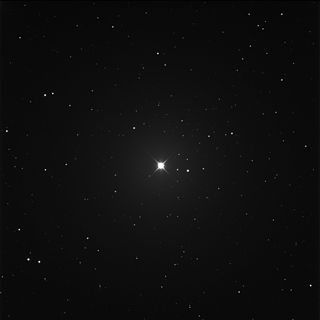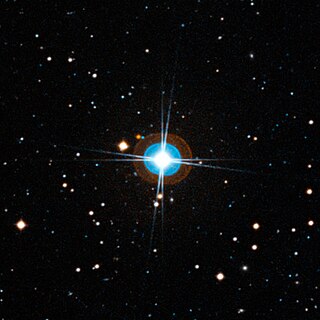
The Solar System is the gravitationally bound system of the Sun and the objects that orbit it. The largest of these objects are the eight planets, which in order from the Sun are four terrestrial planets ; two gas giants ; and two ice giants. The Solar System developed 4.6 billion years ago when a dense region of a molecular cloud collapsed, forming the Sun and a protoplanetary disc.

Virgo is one of the constellations of the zodiac. Its name is Latin for maiden, and its old astronomical symbol is . Between Leo to the west and Libra to the east, it is the second-largest constellation in the sky and the largest constellation in the zodiac. The ecliptic intersects the celestial equator within this constellation and Pisces. Underlying these technical two definitions, the sun passes directly overhead of the equator, within this constellation, at the September equinox. Virgo can be easily found through its brightest star, Spica.

70 Virginis is a binary star located 59 light years from the Sun in the equatorial constellation of Virgo, near the northern constellation border with Coma Berenices. 70 Virginis is its Flamsteed designation. The star is visible to the naked eye as a faint, yellow-hued point of light with an apparent visual magnitude of +4.97. It is drifting further away with a heliocentric radial velocity of +4.4 km/s and has a high proper motion, traversing the celestial sphere at the rate of 0.621 arc seconds per annum.

82 G. Eridani is a star 19.7 light-years away from Earth in the constellation Eridanus. It is a main-sequence star with a stellar classification of G6 V, and it hosts a system of at least three planets and a dust disk.

61 Virginis is the Flamsteed designation of a G-type main-sequence star (G7V) slightly less massive than the Sun, located 27.8 light-years away in the constellation of Virgo. The composition of this star is nearly identical to the Sun.

70 Virginis b is an extrasolar planet approximately 60 light-years away in the constellation of Virgo. Announced in 1996 by Geoffrey Marcy and R. Paul Butler, 70 Virginis was one of the first stars confirmed to have planets orbiting it. When first announced, 70 Virginis b was considered to be within its star's habitable zone, but it was later confirmed that the planet has an eccentric orbit, closer to its parent.

Iota Virginis is a binary star in the constellation of Virgo. Its apparent magnitude is 4.08. Based on its parallax, it is assumed to be relatively nearby, at 72.5 light-years.

Chi Virginis is a double star in the constellation Virgo. Based upon parallax measurements, it is approximately 315 light-years from Earth. It has an apparent visual magnitude of 4.65, which is bright enough to be seen with the unaided eye under suitable viewing conditions.

Gliese 876 d is an exoplanet 15.2 light-years away in the constellation of Aquarius. The planet was the third planet discovered orbiting the red dwarf Gliese 876, and is the innermost planet in the system. It was the lowest-mass known exoplanet apart from the pulsar planets orbiting PSR B1257+12 at the time of its discovery. Due to its low mass, it can be categorized as a super-Earth.

A Super-Earth is a type of exoplanet with a mass higher than Earth's, but substantially below those of the Solar System's ice giants, Uranus and Neptune, which are 14.5 and 17 times Earth's, respectively. The term "super-Earth" refers only to the mass of the planet, and so does not imply anything about the surface conditions or habitability. The alternative term "gas dwarfs" may be more accurate for those at the higher end of the mass scale, although "mini-Neptunes" is a more common term.

Nu2 Lupi (ν2 Lupi) is a 6th magnitude G-type main-sequence star located approximately 48 light-years away in the constellation of Lupus. The physical properties of the star are similar to those of the Sun, though Nu2 Lupi is significantly older.

61 Virginis b is an extrasolar planet, orbiting the 5th magnitude G-type star 61 Virginis, in Virgo. This planet has a minimum mass of 5.1 times that of Earth and is an example of a super-Earth planet. It orbits very close to the star, at a distance of 0.050201 AU with an eccentricity of 0.12. This planet was discovered on 14 December 2009 using the radial velocity method taken at Keck and Anglo-Australian Observatories.
HD 1461 b is an extrasolar planet, orbiting the 6th magnitude G-type star HD 1461, 76.5 light years away in the constellation Cetus. This planet has a minimum mass 6.4 times that of Earth and orbits at a distance of 0.0634 AU with an eccentricity of less than 0.131. It is currently unknown whether the planet is a gas giant like Uranus or Neptune, or has terrestrial composition like CoRoT-7b. This planet was announced on 13 December 2009 after it was discovered using radial velocity measurements taken at the Keck and Anglo-Australian Observatories.
HD 1461 is a star in the equatorial constellation of Cetus, near the western constellation border with Aquarius. It has the Gould designation 32 G. Ceti, while HD 1461 is the Henry Draper Catalogue identifier. This object has a yellow hue and is a challenge to view with the naked eye, having an apparent visual magnitude of 6.47. The star is located at a distance of 76.5 light-years from the Sun based on parallax, but is drifting closer with a radial velocity of −10 km/s.

HD 10180, also designated 2MASS J01375356-6030414, is a Sun-like star in the southern constellation Hydrus that is notable for its large planetary system. Since its discovery, at least six exoplanets have been observed orbiting it, and some studies have proposed up to nine potential planets, which would make it potentially the largest of all known planetary systems, including the Solar System.

An exoplanet is a planet located outside the Solar System. The first evidence of an exoplanet was noted as early as 1917, but was not recognized as such until 2016; no planet discovery has yet come from that evidence. What turned out to be the first detection of an exoplanet was published among a list of possible candidates in 1988, though not confirmed until 2003. The first confirmed detection came in 1992, with the discovery of terrestrial-mass planets orbiting the pulsar PSR B1257+12. The first confirmation of an exoplanet orbiting a main-sequence star was made in 1995, when a giant planet was found in a four-day orbit around the nearby star 51 Pegasi. Some exoplanets have been imaged directly by telescopes, but the vast majority have been detected through indirect methods, such as the transit method and the radial-velocity method. As of 1 January 2024, there are 5,576 confirmed exoplanets in 4,113 planetary systems, with 887 systems having more than one planet. This is a list of the most notable discoveries.

Kepler-62e is a super-Earth exoplanet discovered orbiting within the habitable zone of Kepler-62, the second outermost of five such planets discovered by NASA's Kepler spacecraft. Kepler-62e is located about 990 light-years from Earth in the constellation of Lyra. The exoplanet was found using the transit method, in which the dimming effect that a planet causes as it crosses in front of its star is measured. Kepler-62e may be a terrestrial or ocean-covered planet; it lies in the inner part of its host star's habitable zone.
Wolf 1061d is an exoplanet orbiting the red dwarf star Wolf 1061 in the Ophiuchus constellation, about 13.8 light years from Earth. It is the third and furthest planet in order from its host star in a triple planetary system, and has an orbital period of about 217 days.

AG Virginis is an eclipsing binary star system in the equatorial constellation of Virgo. With a maximum apparent visual magnitude of 8.51 it is too faint to be visible to the naked eye. The system is located at a distance of approximately 820 light years from the Sun based on parallax measurements.














